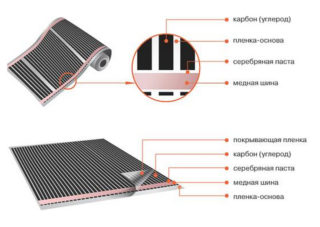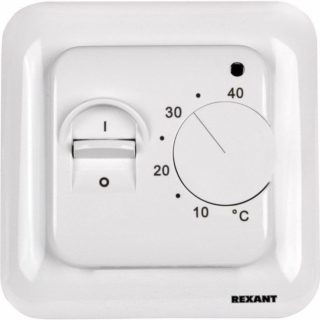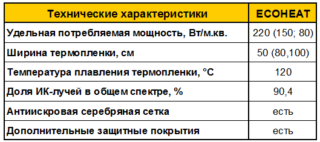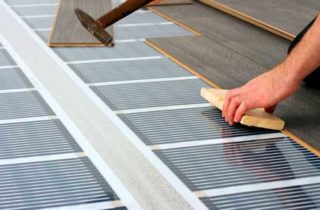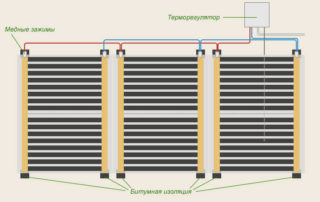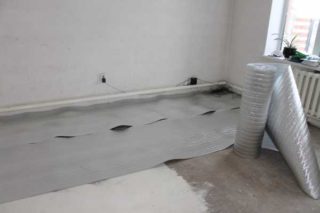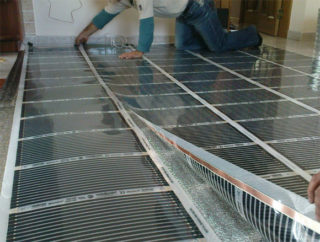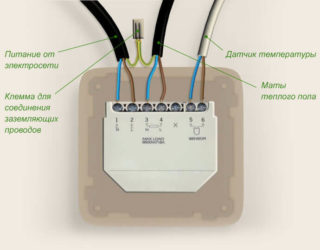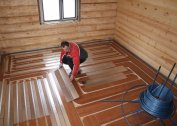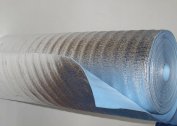Infrared underfloor heating is one of the many electric heating systems in rooms in which the floor acts directly as a heater. Compared with the electric and cable options, the system, which is based on the use of infrared heating film, has undeniable advantages, which is why it is in great demand.
Operating principle
The principle of operation of an infrared film heater is based on the conversion of electrical energy into infrared radiation. Unlike traditional heaters, which heat the surrounding air due to convective heat transfer, infrared rays when heated do not heat the surrounding air, but objects and the human body. The air warms up, receiving heat from objects in contact with infrared waves.
IR radiation is a part of the light spectrum inaccessible to the human eye. The length of the emitted infrared waves is in the range from 5 to 20 microns. Infrared radiation is harmless to humans, which allows its use not only in industry and medicine, but also in everyday life.
Design and working system algorithm
Structurally, the IR floor heating is a heating cloth made of an elastic polymer film with a thickness of not more than 400 microns, on one side of which the thinnest conductive carbon (carbon) tracks are applied. They are made in the form of transverse strips or bee honeycombs. With the passage of electric current, these tracks heat up and begin to generate infrared waves. This generates heat transmitted to the floor and / or surrounding objects.
The consumer may encounter an infrared film with a continuous layer of deposited carbon. Such a film is more reliable and durable, but its cost is much higher.
Power to the conductive paths is supplied through conductors located at the edges of the infrared sheet. They are made of silver plated copper.
Current-carrying conductors are protected from moisture and other damage by a durable hydrophobic coating that does not impede the passage of infrared rays.
Mandatory attributes of the infrared floor are also:
- temperature regulator;
- temperature sensor.
The regulator in conjunction with the sensor is designed to control and optimize the functioning of the entire system. The effectiveness and efficiency of its work depends on it. The system, depending on the version, is equipped with devices with different functional capabilities - from the simplest one that can protect live parts from overheating, to the latest programmer, with which the owner can set the temperature mode of heating, valid throughout the heating season.
The infrared floor operates according to the following algorithm:
- Applying power to the film causes the floor to heat up.
- After the temperature in the zone where the temperature sensor reaches the preset temperature, the latter will command the thermostat to turn off the power.
- The temperature controller turns off the power and the heating element cools to the temperature set by the owner.
After the heater cools down, the thermostat will turn on the power and the cycle will be repeated.
Specifications, Pros and Cons
The infrared warm floor in general has the following technical parameters:
- film thickness, mm - 0.23 ... 0.47;
- web width, mm - 500 ... 1000;
- roll length, m - up to 50;
- power supply voltage, V - ~ 220;
- heating temperature, ° C - not more than 55;
- film heating time to maximum temperature, sec - 20 ... 30;
- the time of heating the flooring to a predetermined temperature, min - not more than 40;
- the melting temperature of the base, ° C - more than 210;
- power consumption, W / hour - 25 ... 35.
Comparing the technical and operational characteristics of electric heating systems, experts note a number of advantages that an infrared warm floor has.
- The film is placed under any type of flooring (laminate, carpet, etc.).
- The installation of the system is simple and easy, since it does not require any preliminary related work (filling the screed, tightening with glue, etc.).
- The absence of screeds and the small film thickness do not reduce the height of the heated room.
- Simple and quick dismantling of the system in the event of relocation or redevelopment of premises.
- Versatility - the film can be laid not only on the floor, but also on the walls or ceiling. In addition, it can be used to heat farm buildings (garage, greenhouse, etc.) and even the porch of a private house, which will prevent its icing in the winter season.
- High reliability - the warranty period established by the manufacturer reaches 10 years or more.
- Silent in work.
- The coefficient of performance (COP) of the system approaches 100%, since there are practically no heat losses;
- Uniform heating of the floor surface in a short period of time.
- Compared with traditional heating systems, the economic effect of using an infrared warm floor reaches 30 ... 35%, and in some cases, for example, when heating large rooms, it can reach 85%.
- Environmental Safety.
Of particular note is the higher comfort than a person using traditional heating methods in a room that is heated with a warm film floor.
The operation of traditional heating systems is based on the principle of convective heat transfer. In this case, first of all, the air in the heater zone is heated, which then moves upward under the ceiling due to turbulent air flows, and cool air drops down. Thus, the main thermal energy is expended on warming the subceiling space.
When heating a room with the Infrared Warm Floor system, the situation is somewhat different. The heat emitted by the heater does not heat the air, but is immediately transferred to the floor covering and objects surrounding it. It is in this zone that people are located. Air heats up from warm objects. At the surface of the floor, the air temperature corresponds to the temperature of the heated floor, warm air begins to rise evenly, gradually giving off heat to objects in the room. Thus, all the useful heat is concentrated in the area where the person is (1.2 ... 2.0 m).
In such a room, a person breathes fresh and rather moist air. Indeed, infrared radiation, unlike other types of heating, does not burn oxygen, which means that there are no products of its combustion and an unpleasant odor in the room. During operation of the system there are no turbulent air flows, which in itself prevents the spread of dust.
Like any other system, infrared floor heating is not without drawbacks:
- the possibility of mechanical damage to a thin film during inaccurate installation work;
- improper installation and violation of the operating rules can lead to fire of the film;
- after turning off the system, the room quickly cools;
- high cost of the system.
Infrared film cannot be stacked under permanently installed large furniture. Violation of this rule may cause overheating and failure of the heating elements.
Choosing an infrared warm floor
Choosing the system "Infrared underfloor heating", it is necessary first of all to proceed from the intended purpose and place of installation.
- In living rooms with normal humidity, it is recommended to use a film with a power of up to 220 W / sq. m
- For rooms with high humidity (bath, sauna, etc.), you need to choose a film with high power (up to 450 W / sq.m.) And improved insulation.
When a laminate, carpet, parquet or their analogs is used as a floor covering, it is advisable to use a film with a power of 160 W / sq.m. This power is enough to ensure a comfortable floor temperature and warm the room as a whole. Under a tile or porcelain tile it is better to lay a film with a capacity of about 200 W / sq.m.
The table below will help you calculate the required system power:

When choosing a film, its quality is of no small importance, which largely depends on the width of graphite strips and current-carrying tires, which should be at least 13 ... 15 mm. The film thickness is also important, which depends on the thickness of the polymer and carbon layers. The minimum allowable thickness of the infrared film is 0.3 mm, but the larger this value, the more protective the shell will be. The presence of additional layers of insulation and the use of non-combustible materials is desirable.
For heating rooms with high humidity (saunas, etc.) it is better to use a film with a continuous layer of carbon. It is characterized by greater power, which will quickly warm up the entire room, and the presence of a water-repellent coating will avoid electric shock.
Mounting IR floor heating
Before proceeding with the installation of an infrared warm floor, it is necessary to perform a number of calculations and develop a layout design. At the same time, the user should keep in mind that in the domestic market he can be offered 2 options:
- Complete - in one box there is everything necessary for installation: film, power wires, temperature controller, temperature sensor, accessories for installation, etc .;
- Cutting-off - a film with a width of 50, 80 or 100 cm. It is cut from a reel in multiples of one running meter, and all the necessary equipment is reached by the user independently.
Layout calculation and project development
They begin the design by drawing the floor plan and indicating the zones of stationary furniture installation on it - in these places the film does not fit.
Film manufacturers recommend laying it out along the long wall of the room. This will reduce the number of cuts.
In the design process, you must also consider:
- cutting of the canvas is performed so that the length of one canvas does not exceed 8 m .;
- the distance from the wall to the infrared film should be from 10 to 40 cm;
- the film should be at least 10 cm from furniture.
Base surface preparation
Before proceeding with the implementation of the developed project, it is necessary to carry out a number of measures to prepare the base on which the infrared film will be laid. The list of these works includes:
- gating walls for laying wires and installing a temperature sensor;
- elimination of unevenness of the base with a thin layer of self-leveling floor. Permissible horizontal deviation - no more than 3 mm .;
- cleaning, washing and drying the base;
- laying a waterproofing film that protects the infrared film from moisture from below;
- base insulation with foil insulation (if necessary). Stack it metallized side down;
It is advisable to check for leaks at the junction of the walls with the floor. Existing cracks can cause significant heat loss. Detected cracks must be “expanded”, cleaned of dust and repaired with foam.
IR film mounting
Laying the IR film is carried out in the following order:
- Mark the floor according to the project, given that overlapping of the paintings is not allowed. The recommended distance between their edges should be at least 5 cm.
- In the center of the heated surface, a temperature sensor is installed, having previously deepened it into the heater. The distance from the nearest wall to the sensor should be at least 50 cm.
- Stack the pre-cut canvas with copper strips down in accordance with the marking.
- Fix the film to the base with small pieces of adhesive tape.
During the work, walking on the IR film is not allowed. Also, you can not put heavy objects on it and drop the tool.
Connecting system elements
Connect the elements of the system to each other in the following sequence:
- The clips included in the mounting kit are connected to the ends of the copper bus.
- Electric wires are installed and connected to the canvas, observing the condition of parallel connection without fail. The use of multi-colored wires will help simplify this task.
- Isolate places of all connections. At the same time, the terminals and ends of the copper busbars on the cut sections of the canvas are protected with tar overlays.
- A temperature regulator is connected to the system and then mounted on a wall in an accessible place. Recommended installation height - 1 m.
- A test inclusion of the system is carried out, checking the uniformity of heating. In this case, there should be no sparking and extraneous noise. If deficiencies are identified, they are eliminated.
- Only after making sure that the system is fully operational and not lacking, can we start laying the flooring.
When performing electrical work, it is necessary to strictly observe the safety requirements set forth in the operating instructions for the Infrared Underfloor Heating system.

